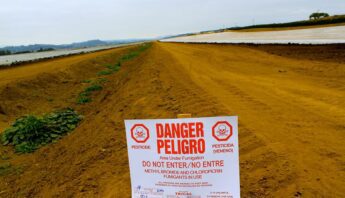For Immediate Release May 27, 2015
Contact: Paul Towers, PAN, 916-216-1082, ptowers@panna.org
 Sacramento, CA – California Department of Pesticide Regulation released new data showing hazardous pesticides continue to be found in the air near California schools, underscoring concerns about rural children’s health.
Sacramento, CA – California Department of Pesticide Regulation released new data showing hazardous pesticides continue to be found in the air near California schools, underscoring concerns about rural children’s health.
Three of the six sites are in close proximity to schools and have documented several different pesticides in the air, including cancer-causing fumigants 1,3-D (Telone) and chloropicrin, and brain-harming organophosphate chlorpyrifos.
In a 2014 report, the California Department of Public Health found heavy use of pesticides in close proximity to California schools. As a result DPR is beginning hearings this week to draft new rules to better protect schools, as well as encourage agricultural innovation zones near schools.
Emily Marquez, PhD, staff scientist for Pesticide Action Network, released the following statement:
“Despite continued shortcomings in the sampling plan, pesticides have been regularly found in state air monitors since the program began in 2011, including cancer-causing and neurotoxic pesticides. These results should spur officials to take further action to protect schoolchildren from volatile and drift-prone pesticides.
DPR’s summary of its air monitoring network data leaves out important contexts. State air monitoring results show continued troubling levels of exposure for sensitive populations such as children. The cancer-causing fumigants 1,3-D and methyl bromide were found in the air at all monitoring sites, including Ohlone Elementary in Monterey County and Rio Mesa High School in Ventura County. The peak use of these fumigants is in the fall, but the sampling scheme continues to be based on one sample per week. As a result, targeted sampling was not done during times of peak use, leaving us with an incomplete picture of what the worst exposures might be during that time.
The new results yet again confirm that pesticide drift is happening. We know pesticides found in the results pose a threat to children’s health. DPR needs to take action to protect the most vulnerable populations in close proximity to agricultural pesticide applications. They should take the latest information as a sign to create stronger no-spray buffer zones around schools and adopt innovative agricultural practices to replace antiquated and hazardous pesticides.”
###







